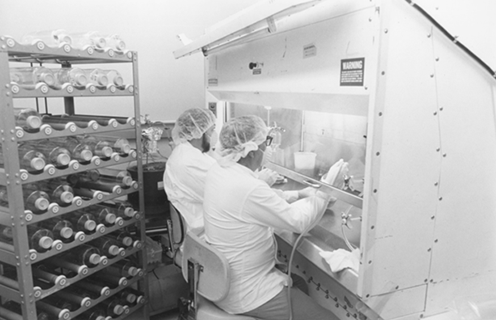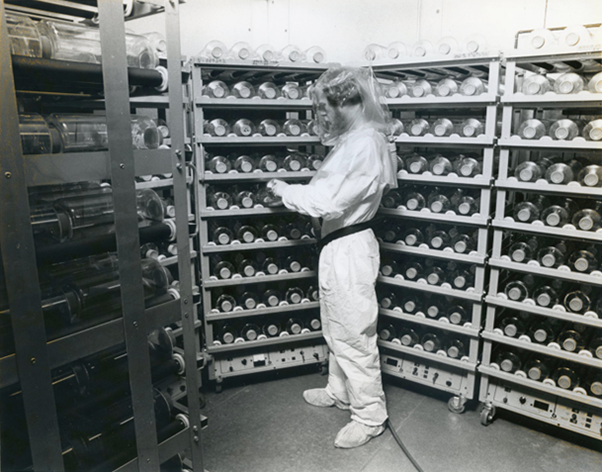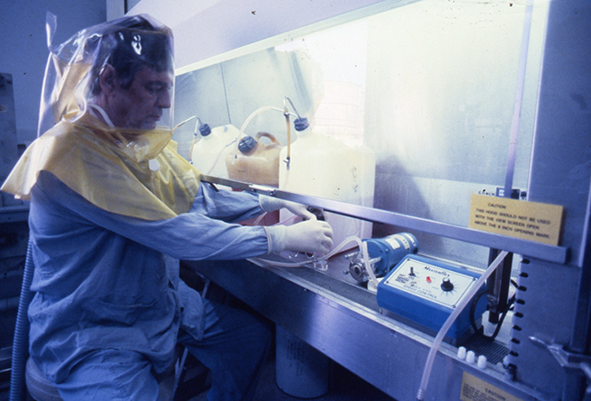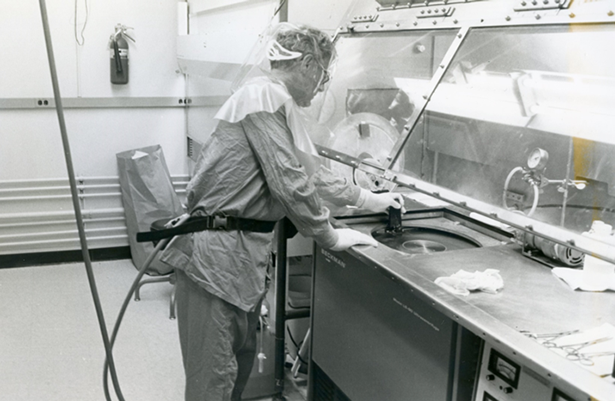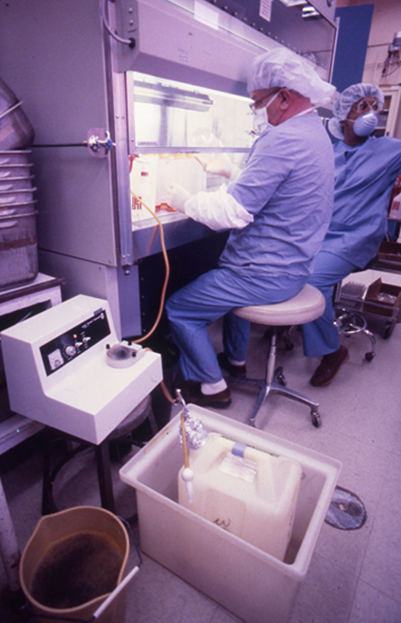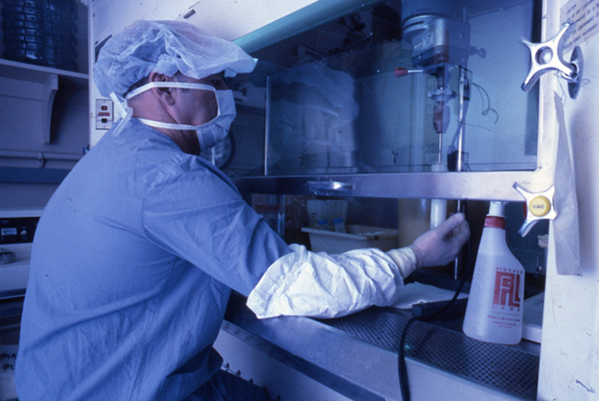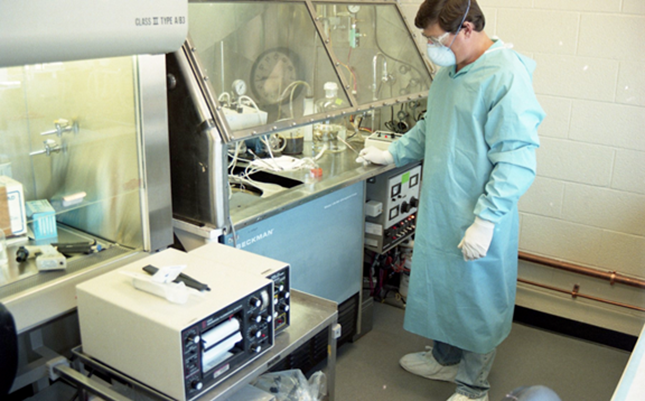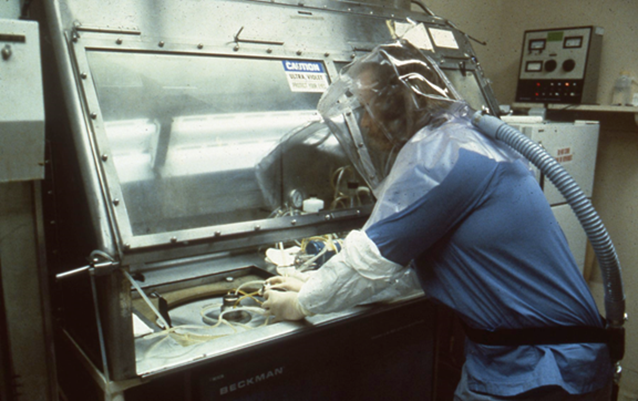Editor’s note: This is an installment of a series about the history of the National Cancer Institute at Frederick and the Frederick National Laboratory for Cancer Research.
On April 9, 1984, a special package from Bethesda arrived at Building 560 on the Frederick Cancer Research Facility (FCRF) campus.
In an unusual move, it came not by courier but by scientist, who carried it directly to a biosafety level 3 (BSL-3) laboratory, at the time one of FCRF’s few facilities for working with highly dangerous biological entities. Exposure to the box’s contents meant likelihood of a protracted death.
Julian Bess Jr. remembers when Larry Arthur, Ph.D., brought that box containing two sealed flasks of HIV-infected cells into their laboratory.
“There was a feeling by some of the team members of being kind of guinea pigs,” said Bess, who is currently a scientist with the AIDS and Cancer Virus Program at Frederick National Laboratory, the successor to the FCRF. “We knew that HIV could be transmitted by bodily fluids, but we didn’t know if it could be transmitted via aerosols while working with the large quantities we would be producing.”
The Right Group in a Crisis
The National Cancer Institute had given the infected cells to Arthur’s laboratory as the nation was in the throes of the 1980s AIDS crisis. AIDS, which is caused by HIV and defined by immune dysfunction leading to death from secondary conditions, had been identified just three years earlier. Of the U.S. population that had been diagnosed so far, approximately half had already died, and diagnoses were mounting.
Among the several hardest-hit groups were people with hemophilia. Nearly half of them had acquired HIV, alarming statistics that added to growing evidence that the virus could be transmitted by blood and blood products—in this case, coagulation factor 8, which was purified from human plasma at the time.
It was a signal that HIV had entered America’s blood supply through donors unknowingly living with the virus. The Centers for Disease Control and Prevention later estimated that approximately 12,000 Americans acquired HIV via transfusions between 1978 and 1984.
This was where NCI asked the team at FCRF to help. The Institute needed HIV for its studies, and the nation needed a test to screen blood samples. In June 1984, the National Institutes of Health awarded contracts to five companies interested in adapting or creating a blood test for HIV.
Both purposes required massive quantities of virus, and Arthur’s team was tasked with producing it.
They were one of the only groups that could do it. Not only did they have the necessary BSL-3 facilities, high-stakes viral production was their specialty. They’d spent the last few years producing HTLV-I, the first discovered human retrovirus (the same family of virus as HIV), for NCI’s studies.
Rapid Production, Rapid Vindication
The team rose to their task and completed a 12-liter pilot lot of virus by the end of May, just seven weeks after they received the first two flasks of cells. Spring and summer 1984 saw them produce 100 liters of virus-infected cells for each of the five companies working on a blood test. Each batch would have filled half of a 55-gallon drum, had it not been concentrated down, said Arthur, who retired as CEO of SAIC-Frederick, the company that previously operated Frederick National Laboratory, in 2011.
“The idea was with that amount they could go into production immediately,” he said.
The team also continued to produce purified HIV-1 for NCI throughout 1984. By the end of the year, they’d finished 80 lots from 6,820 liters of cell culture—an average of roughly one 85-liter lot every two workdays, Bess says—essentially all of which was immediately shipped to researchers in Bethesda. They later learned that this totaled 34 billion infectious doses.
On top of being fast paced, the effort came with great risk to the team. The manufacturing process required pumping and concentrating large amounts of HIV and infected cells. At various points, the material would be centrifuged—a potential spill or aerosolization risk if the centrifuge leaked—and at others, the team frequently handled containers with the virus, some of which were glass, the only kind available at that time. It was a textbook case of escalating the hazard of working with a virus. It demanded careful mitigation through safety controls.
The work was so controlled that the FCRF staff signed a logbook before entering the laboratory so there would be a record of whom to monitor in case of a leak or exposure. They donned full-body protective suits. For certain procedures, they’d swap out their safety glasses, bonnets, and masks for a helmet connected to a plumbed-in air supply. Then, they’d open the door, step inside, and get to work.
Vindication for their efforts came early the following year. In March 1985, the FDA granted licenses for HIV blood tests to two of the five contracted companies.
“I picked it up in April of 1984, and by March of 1985, there were FDA-approved assays. That’s 11 months. That is probably as fast of getting some kind of approval as you could possibly imagine,” Arthur said.
The scientific and medical communities took some time to determine when to deploy the test and how to do so while protecting the privacy of people living with AIDS. However, it wasn’t long before the test began to make a difference. Combined with other measures, it would throttle HIV transmission via transfusion from a tidal wave to a trickle over the next few years.
It was among the first of Frederick’s many major contributions to AIDS research and prevention.
To Build a BSL-3
The BSL-3 facilities in Building 560 were as special as the work conducted in them. They were run-of-the-mill laboratories that had been retrofitted for the purpose—entirely designed and built out by FCRF’s own Facilities teams.
As Arthur’s team was preparing to work with HTLV-I, years before the HIV effort, architects, engineers, and tradespeople working just across campus from 560 visited the building and spoke with the team to ascertain the intricacies of creating a high-containment space. They constructed showers and locker rooms from the ground up. In the laboratories themselves, they built drywall walls around the many pipes and conduits that ran along the ceiling, ensuring that no contamination could enter. Every possible crack and gap was meticulously sealed.
It was the reverse of how such a project would typically be done, where existing pipes would already be hidden and holes for the utilities would be bored into the existing structure. But it was what Frederick staff often had to contend with—and an innovative solution characteristic of FCRF.
“I’m enormously thankful for everything the maintenance team did for us. They helped keep us safe,” Bess said. “They were intimately involved with getting a BSL-3 laboratory validated.”
Unsung Heroes at FCRF
The following individuals worked in the laboratory and were responsible for the large-scale virus production effort.
Virus Production Team:
Jack Rosensteel
Sandy Sloane
Bob Brown
Rich Bauer
Bob Wolfe
Virus Purification Team:
Mike Grimes
Don Schattenberg
Leo Carrigan
John Ewell
Herb Hoffmaster
Samuel Lopez leads the editorial team in Scientific Publications, Graphics & Media (SPGM). He writes for newsletters; informally serves as an institutional historian; and edits scientific manuscripts, corporate documents, and sundry other written media. SPGM is the creative services department and hub for editing, illustration, graphic design, formatting, multimedia, and training in these areas.


